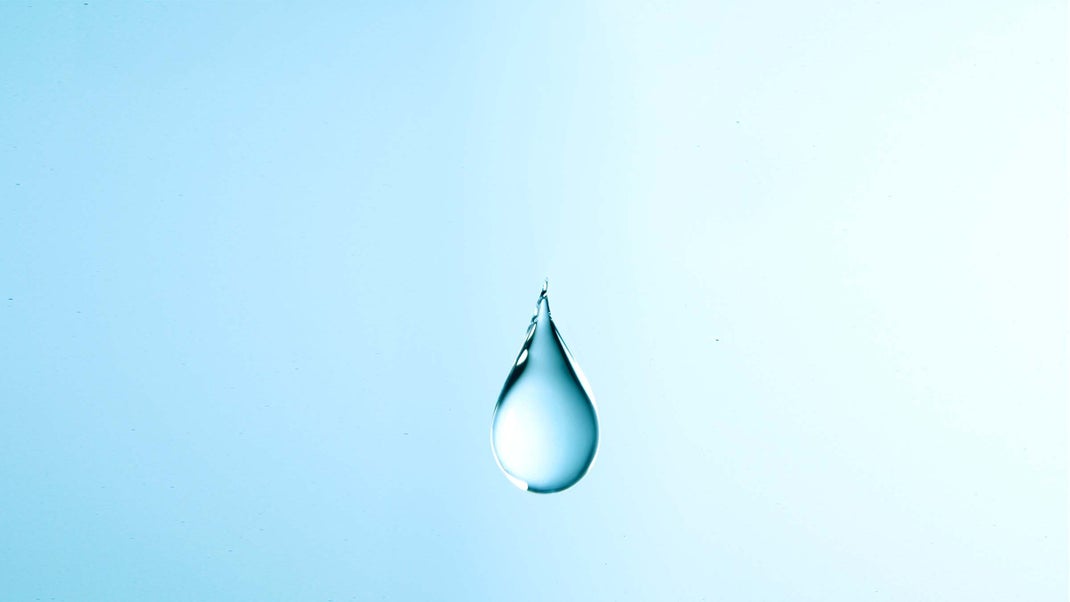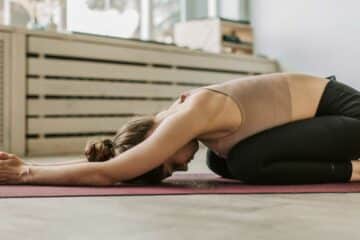It’s not always easy to be a new mom. The post-childbirth Problem No One Talks About—And How Yoga Can Help is the title of this blog post that talks about how yoga can help with post-childbirth problems and issues. The article provides tips and information on how you can get started with your own practice, and also shares some of the benefits that come from practicing yoga.
Just after my best friend gave birth to her second child, I took her out for lunch. Early in our conversation, I asked, “How are you feeling?”
She casually responded, “Well, I pee myself every time I do yoga, but that’s normal.”
Normal? At the time, I was on the fence about having children, so I had no personal experience with the issue, but I knew from various prenatal workshops I had taken over the years that postpartum incontinence during exercise was definitely not normal.
When I became pregnant five years later, I was obsessed with that conversation—and with preventing similar leakage from happening to me. I wasn’t entirely sure how, though. I spoke with my physical therapist, my OBGYN, and my doula. I listened to podcasts, read blog posts and articles, and talked to other moms. Most of the advice focused on perineal massage and the warning, “Don’t tear!” I found nothing on what to do if urinary incontinence—a more tactful term for peeing yourself—actually happened.
Months later, I was eight weeks postpartum with an unpreventable stage 4 tear. I was practicing yoga and my legs were shaking in Virabhadrasana II (Warrior II) because I was trying to regain some strength when I sneezed. Then I noticed my yoga pants were wet. It was no sweat.
I called my bestie in a panic. “Welcome to the club,” she joked in response. I had overheard or taken part in conversations with literally every single postpartum mom and pre-and postnatal yoga teacher I know. Postpartum incontinence happens. A lot.
Why is postpartum incontinence an issue?
According to numerous reports, the United States is ranked one of the worst countries for maternal care. Current postpartum healthcare options simply don’t offer affordable access to the level of care necessary to properly rehab after birth. Pelvic floor physical therapists are rarely covered by insurance, and even if they are, a student once told me that in order to get a referral, “Your uterus needs to be falling out.”
This is very different from France, where the government has been paying for citizens’ pelvic floor rehabilitation since 1985 with a program they call la rééducation périnéale. In the Netherlands, a kraamverzorgster, or home maternity nurse, visits new parents every day for the first two weeks after they come home with the baby.
Why Kegels are not the solution
Jane Austin is the founder and director of Mama Tree Prenatal Yoga School, which educates yoga teachers, doulas, and midwives on how to use yoga to support pregnant people and new parents.
Austin has been working in this field since 1990 and is quite outspoken when it comes to debunking certain mainstream postpartum myths, particularly that leaking is to be expected. “If this is happening, the pelvic floor muscles are not functioning correctly,” explains Austin. While postpartum incontinence is common, according to pelvic floor health experts, it’s not normal.
The other myth Austin is adamant about correcting is that Kegels are the answer for all incontinence, which is what many ob-gyms and mainstream pregnancy apps suggest.
Kegels are usually focused on contracting the pelvic floor. But many pelvic floor therapists and postnatal yoga and movement teachers believe, like Austin, that the exercises fall short in healing urinary incontinence. The problem is that Kegels don’t teach the other essential half of a healthy pelvic floor—the ability to relax one’s muscles. Austin has noticed that overactive pelvic floor muscles—what she calls “hypervigilant”—frequently occur in yoga practitioners who are often trained to hold mula bandha (a contraction of the perineum) during their practice.
“The pelvic floor is just one component of a larger system that helps to stabilize our core and manage pressure within our abdominal cavity,” says Gina Conley, co-owner of MamasteFit, a strength and conditioning gym that supports people through pregnancy, birth, and beyond. Conley has found that focusing solely on one body part might lead to coordination issues, such as leaking or other dysfunction. This means that the very exercise most doctors prescribe to help with peeing oneself could potentially worsen it.
Michelle Madrid was prescribed Kegels by her OB nurse practitioner after her first child. The nurse practitioner also “reassured” Madrid that this would likely continue to happen whenever she sneezed or coughed.
Madrid healed fairly quickly after her first child. Unfortunately, after her second child, Madrid’s urinary incontinence returned to the point where she leaked every time she lifted her leg in Three-Legged Downward Facing Dog or simply sat back in Utkatasana (Chair Pose).
It was at this point Madrid decided to ask her doctor for a referral to a pelvic floor physical therapist. She was unaware such help even existed until after her second pregnancy when some parents from her postnatal yoga class recommended it. Madrid was told that her case was not severe enough for insurance to cover her visits.
She turned to YouTube and her mat. Through certain postures, breathwork, and contraction and relaxation exercises, Madrid managed to improve her urinary incontinence greatly, although running can still be a challenge if her bladder is not empty.
Can yoga help with postpartum urinary incontinence?
Yoga is never a replacement for medical treatment, though there are certain movements and breathing exercises that can help new parents recover postpartum. Though the answer can be highly individual, there are several factors that can aid in the recovery of those who suffer from postpartum incontinence:
Breath
Many of us, postpartum or not, breathe incorrectly. When everything is properly functioning, on an exhale, the pelvic floor contracts, and the sit bones draw toward one another. On an inhale, the pelvic floor relaxes and the sit bones widen as if they were making space for the breath.
When I had my first session with a pelvic floor physical therapist postpartum, I could not believe how backward my breathing was—and I teach breathing for a living! The natural breathing pattern is especially disrupted during labor when many are instructed to push out and down on the exhales.
Conley launched MamasteFit with her sister, Roxanne Albert, a labor and delivery nurse, in 2017. She has learned that you can tell a lot about a person from their breathing patterns and how they work their accessory core muscles. While many yoga classes do not focus on connecting breath with the pelvic floor, you can always be conscious of allowing your pelvic floor and breath to follow the natural pattern of contraction on an exhale and softening on an inhale. Poses that you can feel and that access this pattern include Marjaryasana (Cat Pose) and Bitilasana (Cow Pose).
Core
Conley has a Master of Science in Exercise Science and wrote her thesis on fitness in the pre-and postnatal population. During her first pregnancy, she felt misguided by popular advice regarding working out, both before and after she gave birth.
One of Conley’s observations, both in her coursework and her experience, is that pelvic floor health is dependent on the coordination with the rest of the core stabilization system.
This includes the diaphragm (the dome-shaped muscle beneath the lungs that influences the breath), transverse abdominis (the deepest core muscles that act as a corset across our trunk), obliques (the muscles that instigate side bends and twists), and multifidus (the lumbar-stabilizing muscles).
MamasteFit offers childbirth education, doula services, and online services, such as 1:1 care with a pelvic floor physical therapist, as well as online group pelvic floor wellness sessions. For example, in virtual 1:1 physical therapy sessions, the therapist asks the client to do a few squats to observe how the person moves and inquire verbal feedback on adjustments they suggest.
A great pose to access the transverse abdominis and multifidus is the Tabletop with the toes curled and knees hovering a couple of inches above the mat. Although any twist will engage your obliques, Parivrtta Prasarita Padottanasana (Twisting Wide-Legged Forward Bend) is an especially good pose to access all three of these muscle groups at once. (Come into standard Wide-Angle Standing Forward Bend and reach your right hand to your left ankle and rotate your chest to the left. Breathe, release, and switch sides.)
Adductors
The inner thigh muscles known as the adductors are perhaps better known in yoga classes for being central to hip and core stabilization, yet they also contribute to pelvic floor stability. Shaped like a fan, this group of muscles connects the pelvis to the femur (thigh bone). Strengthening these muscles can be helpful if you are experiencing postpartum urinary incontinence.
Poses that access the adductors include any that draw your inner thighs toward the center of your body, such as Garudasana (Eagle Pose) and Bakasana (Crow Pose).
5 yoga poses that can help postpartum incontinence
Yoga is not a substitute for professional help or medical expertise. That said, some postures can be helpful for re-coordinating your core stabilization system and your breath.
Before picking a pose or area to focus on, MamasteFit recommends observing your breath patterns in different orientations, such as on your back, side-lying, seated, hands and knees, low lunges, and standing to see what feels most challenging, as that is an indicator of the area or movement that you should focus on—within reason, of course.
Bitilasana and Marjaryasana (Cow and Cat Poses)
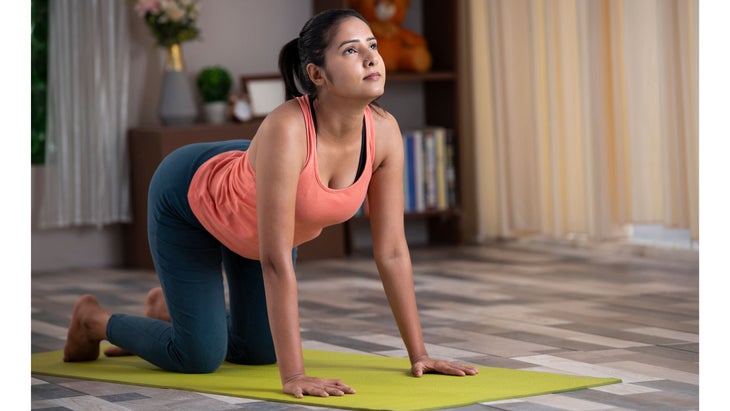
Why it helps: Because the breath is so important in healing pelvic floor dysfunction, any dynamic sequence that coordinates breath with contraction and relaxation can help retrain your natural rhythm. Being on all fours makes the pose accessible and provides an orientation that helps core stability since you are working to lift your front up against gravity.
How to: Come to hands and knees. On your exhale, round your back and contract your pelvic floor to draw your sit bones toward each other. On the inhale, release your belly toward the mat and bring a slight arch to your back as you relax the pelvic floor to broaden the sit bones.
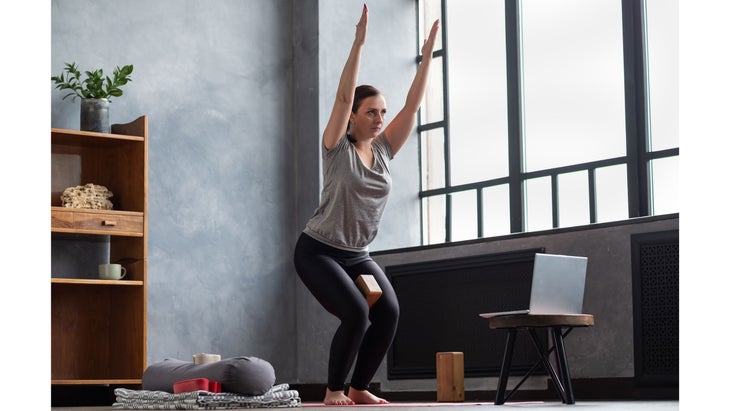
Utkatasana (Chair Pose) With Block
Why it helps: Melanie Salvatore-August, a yoga teacher and author of Yoga to Support Immunity, has given birth to three babies, each weighing more than 8 pounds. Her pelvic floor dysfunction after her third birth included sacroiliac instability. This is the joint connecting the sacrum, the fused part of our lower spine, to our hip bones or ilium. The instability got so bad that she had to teach yoga while sitting in a chair due to the severe pain in her pelvic floor and hips.
One of Salvatore-August’s favorite exercises is to place a block between your inner thighs in Utkatasana (Chair Pose) and practice tiny squeezes and releases of the pelvic floor muscles.
How to: Come to standing with your feet together and your heels slightly apart. Place a block between your thighs. If you need to take your feet a little wider, that’s fine. Bend your knees, reach your bum toward the wall behind you, and bring your arms alongside your ears. Practice tiny squeezes and releases of the pelvic floor muscles. Salvatore-August reminds us that we should focus not only on the contraction but also the release. Exhale and squeeze. Inhale and release. This is a great pose to strengthen the adductors, which also play a role in core stability.
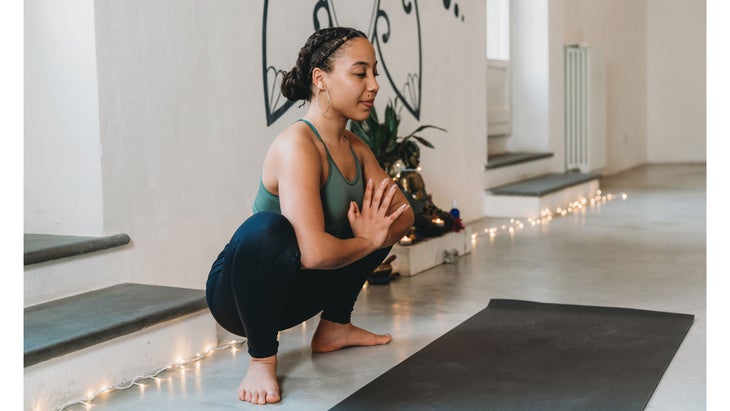
Malasana, Variation (Dynamic or Wave Squat)
Why it helps: One of Austin’s favorite pelvic floor exercises, whether someone has given birth or not, is what she calls the Wave Squat. The most essential aspect is squatting down on the inhale when the sit bones naturally widen and then standing up on an exhale when the contraction of your pelvic muscles draws the sit bones toward one another.
How to: From standing with your feet about hip distance apart, inhale and bend your knees toward Malasana (Garland Pose) or a squat-like shape, with your feet turned out. Squat to whatever extent is comfortable for you. On your exhale, press down through your feet to rise and stand. There is no need to squat super deep. Do not continue if you feel pain in your knees or hips.
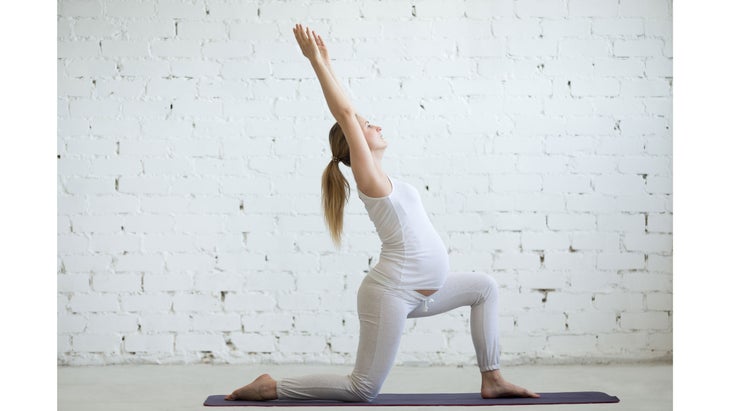
Anjaneyasana (Low Lunge)
Why it helps: Asymmetrical shapes can reveal what’s happening throughout your pelvic floor. Conley recommends thinking of the pelvic floor in quadrants, as in the front (anterior), back (posterior), and left and right sides. Low Lunge can tell what’s happening in the side and posterior of the bent knee leg. This pose is also helpful at regaining pelvic floor stability in the front leg as we can focus on plugging our femur bone (thigh bone) back into the socket, as well as hugging our front inner thigh toward the midline, which engages the adductors. This pose also stretches the posterior portion of your pelvic floor.
How to: Come to a lunge with your left knee bent. Lower your right knee to the mat. Situate your left knee over your left ankle. Start with your hands on your hips. If desired, reach your arms alongside your ears and settle into your breath. Hook your left thumb in your outer right hip crease to square your pelvis toward the wall in front of you. Next, place your right hand on your inner left thigh and gently press your leg into your hand and your hand into your leg, activating your adductor (inner thighs) as you breathe into your pelvic floor. Inhale down and out. Exhale up and in. Release and switch sides.
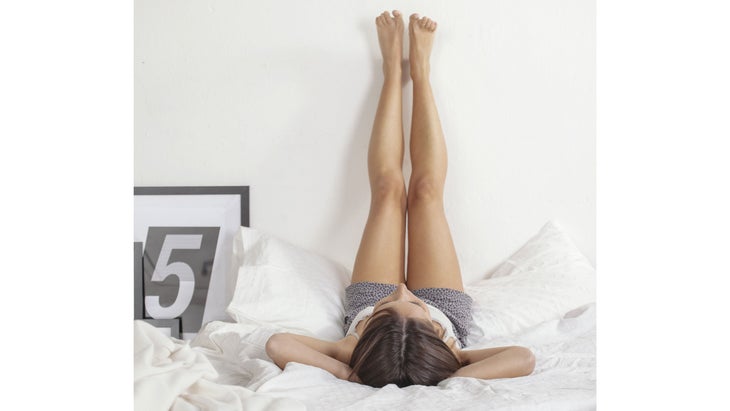
Viparita Karani (Legs-up-the-Wall Pose)
Why it helps: If you have a hyper-vigilant pelvic floor—meaning you are constantly contracting the muscles—Austin recommends practicing any passive symmetrical shape (in which the sides of your body are doing the same thing) and there is little if any, the physical effort required to remain in the pose. This includes Savasana (Corpse Pose), which allows you to practice relaxing those muscles, and Viparita Kirani (Legs-Up-the-Wall Pose), in which you have the support of the floor and the wall and can feel secure enough to relax. You can even do it from bed.
How to: Bring your yoga mat up against the wall or come onto your bed. Place one hip alongside the wall and slowly lift your legs up against the wall as you lower your upper body down. Your bum should be a few inches from the wall. You can take a folded blanket or a pillow beneath your low back. Bring your feet about hip-distance apart and let the weight of your legs rest against the wall. Relax your feet, legs, pelvic region, abdominals, shoulders, and arms. You may want to scoot your shoulder blades away from one another. Bring your arms wherever is comfortable.
Imagine that with each inhale, your sit bones spread and your pelvic floor relaxes. On your exhale, observe if you are gripping. Remember, there will always be a slight contraction with every exhale, but having your legs up the wall can give you feedback on whether that contraction is being overdone.
Conclusion:
The Post-Childbirth Problem No One Talks About—And How Yoga Can Help The post-childbirth problem no one talks about can be alleviated by strengthening and toning your pelvic floor.
The physical effort required to remain in yoga poses such as Malasana (Garland Pose) and Viparita Karani (Legs Up The Wall), or passive symmetrical shapes, relaxes the muscles of the pelvic floor so that we may gain awareness over what is happening within it.

